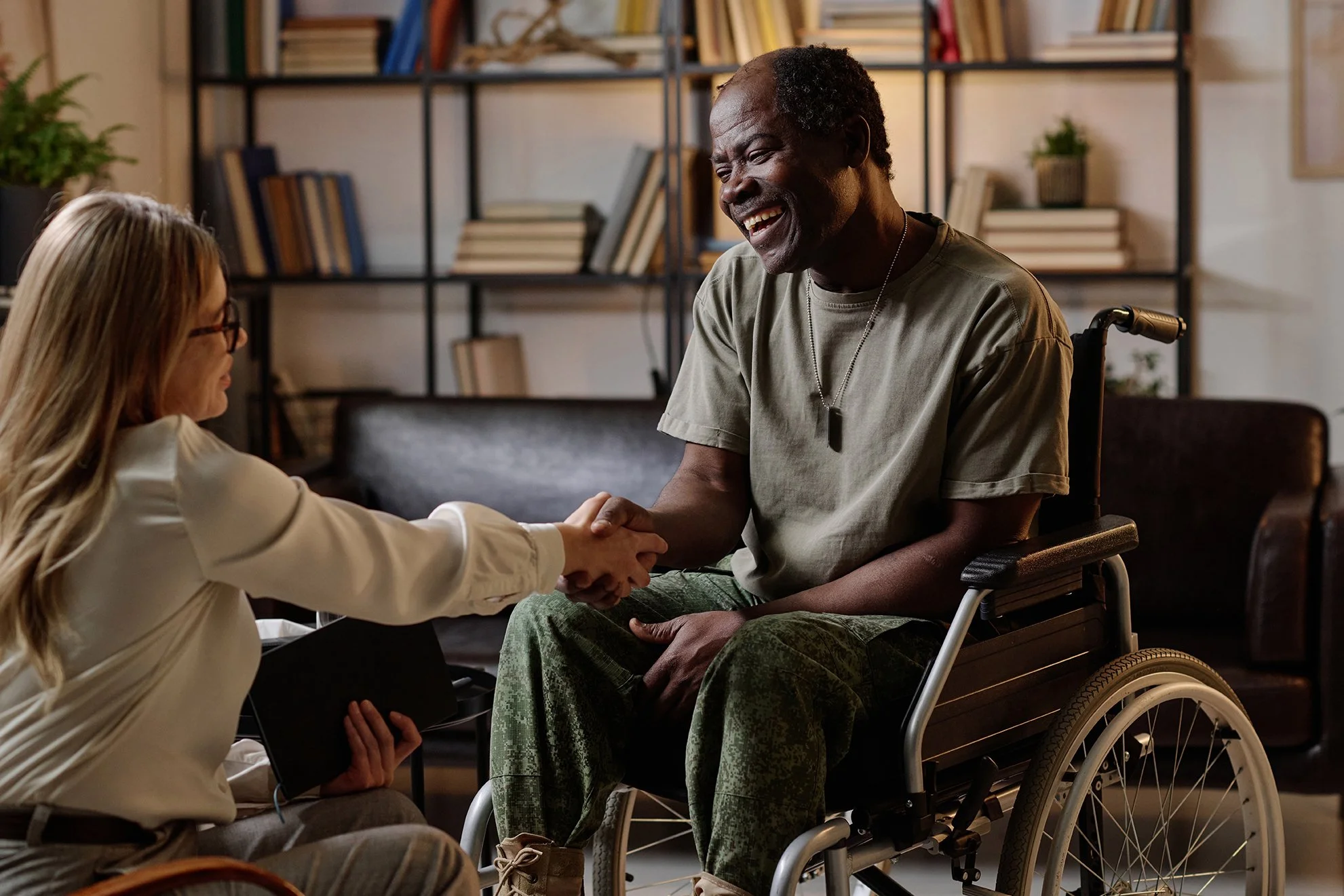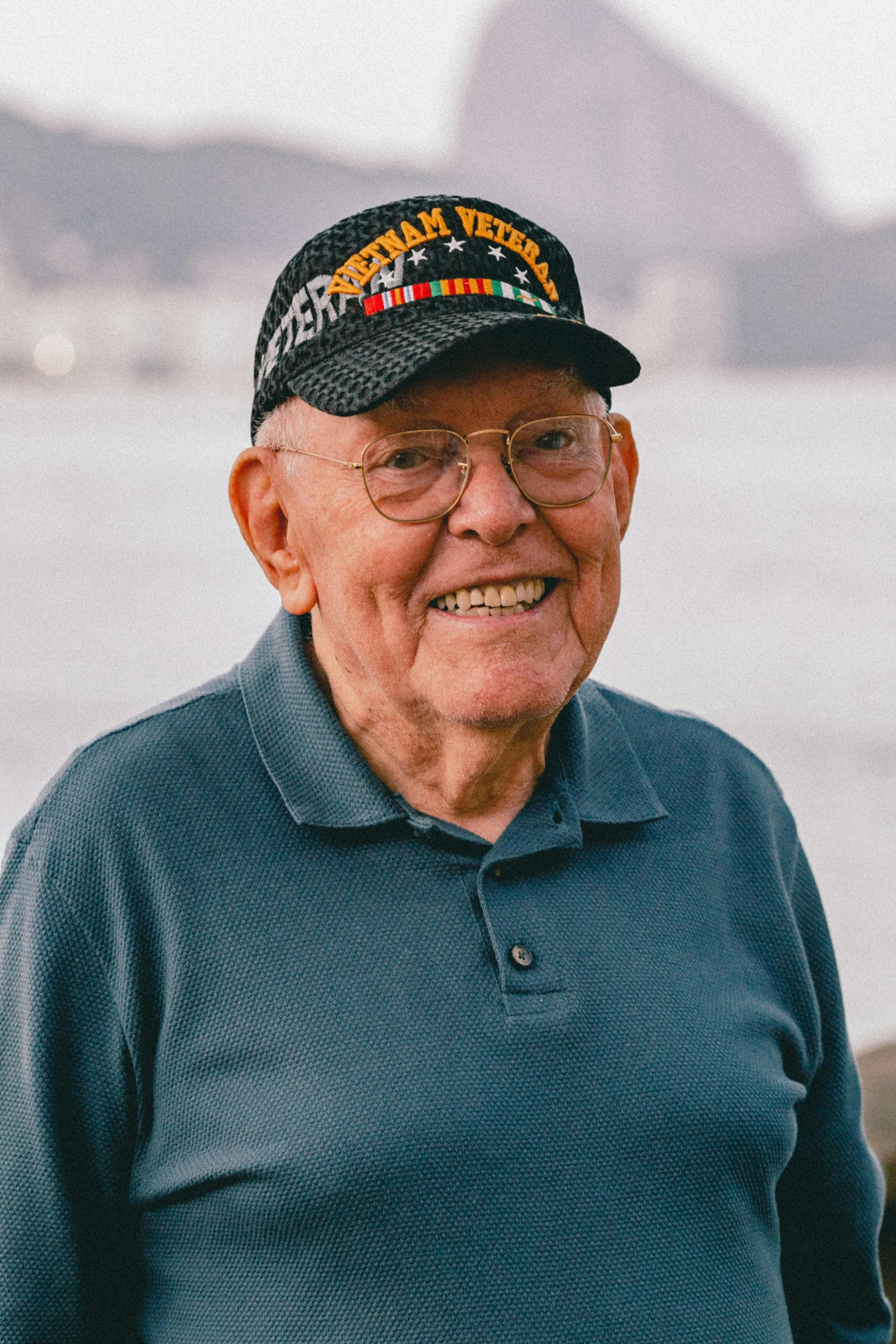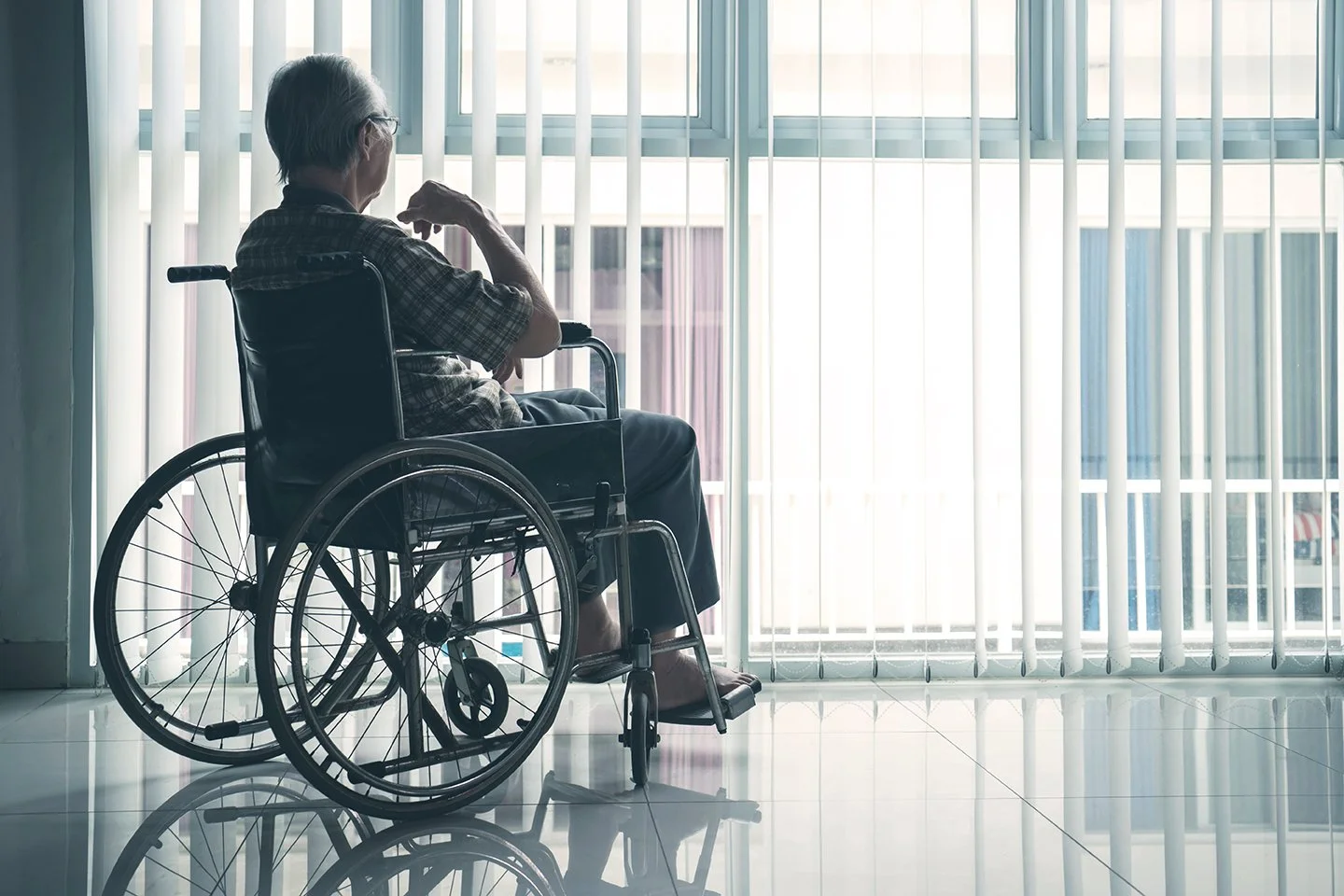Veteran Directed Care: Helping Veterans with Disabilities Live Independently, at Home!
Image: A man who is a wheelchair user shakes hands with a woman inside his home. He wears military fatigues and a dog tag around his neck.
Part I: The Benefits of Veteran Directed Care (VDC)
By Wes Carter and Connie Stafford
About the Authors
Wes is an Army/USAF Veteran with a disability and a VDC participant. Connie is a USAF Veteran with a disability and a Veterans Independence Program Advisor at the Center for People With Disabilities (CPWD.org).
For many Veterans, Independence often means the ability to continue living wherever and however we wish, even when faced with life’s inevitable burdens of aging or disability. These issues often bring on difficult conversations about assisted living, nursing homes, finances, and worries about loss of independence.
Image: A man sits at a table with his daughter while she breaks up pieces of food for him on a plate.
The good news is there’s a great program that empowers Veterans who need long-term service and support to live independently at home. For Veterans with compromised activities of daily living (ADLs) and who face challenges living safely at home, the Veterans Administration (VA) developed Veteran Directed Care (VDC). VDC provides Veterans an annual stipend that gives them the means and the freedom to hire and train caregivers of their choosing, even family or friends.
Through VDC, Veterans manage their own VA-provided budget, hire and pay caregivers of choice, and manage other vital independent living services in their own homes!
The Department of Veterans Affairs respects and supports the precious freedom of independent living, offering this benefit to qualified Veterans of all ages, peacetime or wartime, regardless of income. No service-connected disability is needed – just the need for independent living services.
Kati Simons from the Cheyenne VA Medical Center explains, “As a social worker who provides care to our geriatric population, one of the biggest challenges is allowing Veterans to remain in their homes and receive the care they need to be safe. VDC is one of the options that we have that allows Veterans to remain in their homes and be cared for by family and friends.”
VDC is available nationwide for any Veteran enrolled in VA health care who meets clinical requirements. This includes Veterans enrolled in VA health care having difficulty living independently, or who, without help from others, would be faced with considering admission to a long-term care facility. The money provided under VDC is tax-free and does not affect other retirement or disability incomes. To get started, Veterans should have a conversation with their primary care provider or a VA social worker to determine eligibility and begin the enrollment process.
Why is VDC so Important?
When Veterans cannot perform ADLs independently on their own, living at home can be very difficult. ADLs include bathing, dressing, hygiene, eating, and walking; meal preparation, medication management, and transportation. These seemingly simple tasks can become overwhelming for Veterans with disabilities, and without supportive programs for independent living, such as the VDC, can lead to premature transition into nursing care. Often, friends and family step in to assist Veterans with ADLs, but this can levy physical and financial burdens, and is typically unsustainable.
In Colorado, the Cheyenne VA contracts with the nonprofit Center for People With Disabilities to counsel Veterans in the program. Connie, or staff member at CPWD, works with Veterans to design a detailed budget and plan for caregiving and VA approved goods and services. Veterans themselves become the actual employers, hiring their chosen caregivers who are then paid through VDC.
Harry’s Story
Harry is a 90-year-old Veteran in Fort Collins and a church friend of this writer. His family has seen the benefits of VDC. Harry was in the Army more than 70 years ago. Aging and illnesses led Harry to move in with his son and daughter-in-law. Harry and his family chose to be together at home rather than send him to assisted living or long-term care.
Image: An elderly man smiles to the camera. He wears a Vietnam Veteran baseball cap.
For a long time, Harry and his family struggled to meet his independent living needs because he required a lot of assistance to perform ADLs. Fortunately, the family learned about VDC from other Veterans at church. Interested, they discussed Harry’s situation with a Cheyenne VA social worker. Harry signed up for VDC within just a few weeks. A care plan and budget were developed, and funds became available.
Together, Harry and his VDC advisor elected to use his VDC budget to pay a family member 40 hours per week for home care. VDC funds have also been used to pay for home-delivered meals and contractors for essential yard work and snow removal. The financial and contractual support relieved the family of the overwhelming burden of caring for Harry, while allowing them to stay together and get outside help.
VDC also offers respite care through the Cheyenne VA Medical Center, which gave Harry’s family a two-week break from their caregiver responsibilities, so they could attend to their own lives and needs. In reflecting about how things have changed since enrolling in VDC, Harry’s son exclaimed, “VA care and compassion are second to none!!! So appreciate our VA!”
Getting Started with VDC
The program can be a lifesaver for Veterans like Harry and their families. VDC is also essential for Veterans living alone, who can’t find adequate outside agency home care, can’t afford contractual care, or are experiencing a burden from family members caring for them. VDC is focused on the Veteran, their needs, their choice of care and support, their well-being, and their independence. The VA also has additional programs that provide support for Veterans who require skilled care from contracted home care agencies.
If you are a Veteran interested in VDC, or know a Veteran who could benefit from VDC, talk to your VA primary care team about VDC to get started. You can also call the Cheyenne VA Medical Center at (307) 778- 7550, and ask for the Social Work Department. Not all VA staff are familiar with the VDC, so you may have to ask to find the right person to talk to.
Part II: The Impact of VDC on Independence
How the VA Shifted from Institutions to Independence
By Jude Sky
For decades, the standard path for Veterans requiring significant long-term care was institutionalization. In the years preceding the new millennium, the Department of Veterans Affairs (VA) long-term care system was heavily reliant on nursing homes and group residential settings.
Image: An elderly man sits in a wheelchair, looking out a large window inside a nursing home.
This dependence was reflected in the agency's spending: As recently as 2002, approximately 89% of all VA long-term care expenditures were dedicated to institutional care (IC). This massive allocation meant that for most aging Veterans, or Veterans with significant disabilities, the only reliable way to live was to give up their home and independence for institutionalization. However, the institutional path was both financially unsustainable and fundamentally misaligned with Veterans' clear preference to age in place.
The Mandate for Change
The turning point came with the Veterans Millennium Health Care and Benefits Act of 1999. This legislation didn't just suggest a new approach; it mandated that the VA begin providing non-institutional care, such as home health and adult day services, as a core benefit.
This mandate initiated the "great rebalancing"—a systematic effort to shift resources and focus from costly nursing homes to Home and Community-Based Services (HCBS).
The Rise of Veteran-Directed Care (VDC)
The subsequent development and expansion of programs like the Veteran-Directed Care (VDC) program provided the essential funding and services that would enable Veterans to achieve and maintain independence. VDC directly empowers Veterans who are assessed as being at high risk of nursing home placement by giving them a personal budget to hire, train, and manage their own care providers and services.
This shift has created a quantifiable, positive change:
· Cost Efficiency: The shift saves taxpayer dollars. Studies have shown that VDC is a far more cost-effective way to deliver long-term support than traditional institutional care.
· Reduced Institutionalization: VDC has proven its ability to prevent nursing home admissions. Participants in the VDC program have demonstrated a 37% decrease in nursing home use compared to Veterans receiving other traditional, less flexible home services.
The result of VDC is staggering. The overwhelming majority of the Veteran population is now living independently. Of those not living in their own homes:
· Approximately 85,000 are living in institutional care settings
· Approximately 36,000 are homeless
CPWD’s Veterans Independence Program (VIP)
Image: A man wearing military fatigues sits in a wheelchair in his home. He has an American flag in his lap. Next to him is his daughter, and behind him is his wife.
CPWD works with the VA to provide VDC services to Veterans throughout Colorado, northeastern Colorado, southern Wyoming, Nebraska, parts of Western Iowa, and parts of California. Our Veterans Independence Program Advisors act as bridges between the VA and Veterans, as well as allies for the Veterans and their families. Through the VIP program, Veterans can connect to VDC resources, get assistance creating an independent living budget, hiring home care, and with a variety of other independent living needs. CPWD also offers independent living skills training for those needing assistance with mobility, technology or other skills that would support independent living.
To learn more about our VIP program, please visit this page.
You can also watch this recent video about Veteran Mark’s experience with life and how VIP helped him.
Thank you to all our Veterans, and to those who support independent living for our Veterans!






